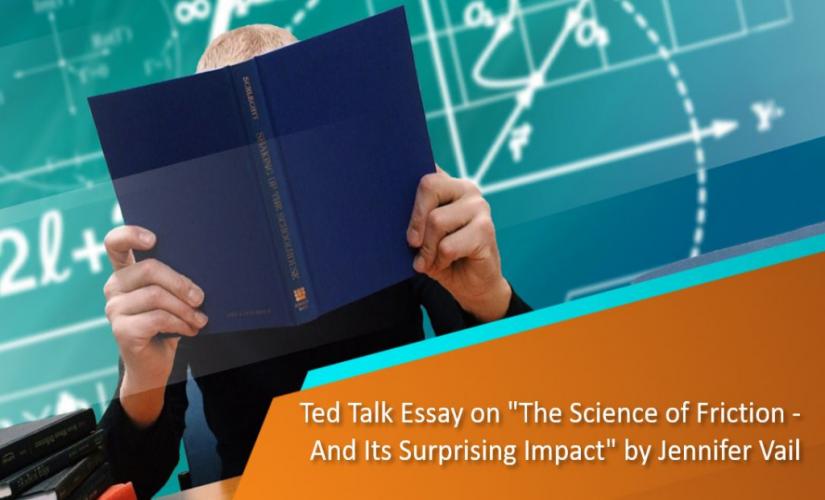Essay on What It Means to Be Intersex
- 842 words


In this Ted Talk essay on “The Science of Friction – And Its Surprising Impact” by Jennifer Vail, a paper covers the speaker who discusses what she does as a tribologist. In this case, she presents to the audience with much enthusiasm and humor. Also, the talk stressed on friction and how to save energy by reducing its consumption. In turn, the Ted Talk presentation explains the field of tribology using relatable tasks, like brushing teeth and ballerina dances, as Vail capitalizes on persuasion to entice the audience to appreciate and reduce friction, saving energy.
Several things were described in the video. Basically, the first was how she made the presentation using basic and relatable tasks, like brushing teeth, ballerina, driving, plaque removal, wear and tear of shoes, and car tires, among other things. Also, Vail acted out some parts, like placing her foot in a tiptoe position to explain how they used rosin in ballerina sessions (00:03:25 – 00:03:29). In turn, the efforts made it easy for people who knew nothing about tribology to understand the concept by using humor and demonstrations. Therefore, in order to pass the message to the audience, humor and illustrations made the presentation more relevant.

In order to catch the audience successfully, it is highly dependable on increasing the effectiveness of a presentation. In this case, the interesting factor is that tribology research plays a vital role in increasing efficiency and reducing energy consumption. According to Vail, tribology can help the United States to save more than 3,600,000 000 barrels of oil (00:10:12-00:10:27). Basically, the vast amount of fuel would be useful in other courses. Then, another exciting thing about the talk was when Vail stated, “Overcoming friction takes energy… about one-third of the fuel you put into your internal combustion engine vehicle will be spent overcoming friction” (00:9:08-00:9:24). In turn, she presents these facts, among others, about friction and tribology that the audience would barely acknowledge, while people experience them every day, keeping them interested. Hence, an interesting perspective on presentations keeps the audience engaged.
The presentation was done with a lot of expertise. However, there were some things that fell short. For instance, according to Hutchings and Shipway, tribology draws on the expertise of chemists, physicists, mechanical engineers, and material scientists (1). Based on this fact, the speaker should create a connection to these disciplines, which people understand better, to drive her point. In addition to that, Leonardo da Vinci was the father of modern tribology (Sorin-Bogdan and Benea 7). Such a fact would help the audience understand how long tribology has been in existence and its source, which would have kept the talk even more interesting. Hence, expertise is not the only thing that can be looked at in a presentation, but Vain should use the connections to other subjects and facts with which people are more conversant.
Being persuasive in a presentation helps improve understanding. In this case, the speaker uses gestures and rhetorical questions to pass the message to the audience. For example, “If you’re moving your ankle or wiggling your ankle at all, did it make a popping sound? You’ve had that, right? (Vail 00:02:29-00:02:31). In this case, she uses influence to be able to connect with the audience and juggle their minds to help them understand what she wants to deliver. At the end of her speech, she encourages the audience to see tribology in the world around them, and she recommends to think about how they would improve the interacting surfaces they experience. Also, Vail covers some examples of facts to illustrate the concept of tribology without bias. Thus, being persuasive is a great skill, and eliminating bias helps in an effective presentation.
The audience can learn new things and do more research. In this case, people appreciate friction and appreciate tribology, which helps them save energy. Moreover, people can apply this information on their day to day activities, like wearing socks while walking on a waxed floor, using powder on shoes while dancing, and using lubricants while moving things against a surface. In turn, there are some types of friction, which include kinetic friction between objects in motion, and static friction, which exists in two resting objects (Ghose par. 4). Therefore, friction existing in all types and nature of objects, and, using the information from the talk, people can decrease it where possible. Thus, this information will help people in reducing unwanted friction.
Therefore, the Ted Talk, which was presented on the TED stage, focused on the concept of tribology, and Vail helps the audience to have a better understanding of it. Ideally, most people do not give much thought to the science of friction, so they only know the basics. In turn, friction may not be a fundamental force like gravity, but it helps with basic tasks, Moreover, tribology helps counter unwanted friction to increase efficiency.
Ghose, Tia. “What is Friction” Live Science, 2013, www.livescience.com/37161-what-is-friction.html.
Hutchings, Ian, and Philip Shipway. Tribology: Friction and Wear of Engineering Materials. Butterworth-Heinemann, 2017.
Sorin-Bogdan, Basa, and Lidia Benea. “Tribocorrosion–Insight Into Material Degradation in Specific Environments.” The Annals of “Dunarea de Jos” University of Galati. Fascicle IX, Metallurgy and Materials Science, vol. 37, no. 1, 2014, pp. 5-12.
Vail, Jennifer. “The Science of Friction – And Its Surprising Impact on Our Lives.” TED, 27 February 2020, www.ted.com/talks/jennifer_vail_the_science_of_friction_and_its_surprising_impact_on_our_lives.